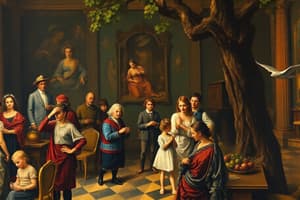Podcast
Questions and Answers
Match the following terms with their definitions:
Match the following terms with their definitions:
Organizational culture = Set of shared values and norms that control organizational members’ interactions Values = General criteria, standards, or guiding principles used to determine desirable or undesirable behaviors Terminal value = Desired end state or outcome that people seek to achieve Norms = Standards or styles of behavior considered acceptable for a group of people
Match the following with their examples:
Match the following with their examples:
Instrumental value = Working hard, being honest, taking risks Organizational culture = Controlling the way members make decisions and interpret the organizational environment Terminal value = Desired mode of behavior Norms = Acceptable or typical standards of behavior
Match the following with their influence on organizational effectiveness:
Match the following with their influence on organizational effectiveness:
Values = Determining which types of behaviors, situations, and outcomes are desirable or undesirable Organizational culture = Controlling the way members behave and manage information Norms = Setting the acceptable or typical standards of behavior for a group of people Terminal value = Affecting the desired end state or outcome sought by individuals
Match the following with their impact on decision making:
Match the following with their impact on decision making:
Match the following cultural differences with their impact on organizational behavior:
Match the following cultural differences with their impact on organizational behavior:
Match the following socialization tactics with their descriptions:
Match the following socialization tactics with their descriptions:
Match the following ceremonial rites with their purposes:
Match the following ceremonial rites with their purposes:
Match the following factors contributing to organizational culture with their descriptions:
Match the following factors contributing to organizational culture with their descriptions:
Match the following stakeholder group with their property rights:
Match the following stakeholder group with their property rights:
Match the following term with its description:
Match the following term with its description:
Match the following approach to social responsibility with its description:
Match the following approach to social responsibility with its description:
Match the following statement about culture management with its explanation:
Match the following statement about culture management with its explanation:
Match the following reason for being socially responsible with its explanation:
Match the following reason for being socially responsible with its explanation:
Match the following term with its source:
Match the following term with its source:
Flashcards are hidden until you start studying




